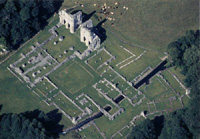 |
 |
 |
 |
 |
 |
 |
|
The abbey precinct (1/1)
The abbey precinct covered some 31 acres and was bounded by a thirteenth-century stone wall, c. 3m high, traces of which survive. Like all abbeys the precinct at Roche was divided into zones and access was restricted. Entrance was via the outer gatehouse, which lay to the west of the church - on the site of the present car-park. A walled lane led to the inner gatehouse, which had two gateways: one led to the outer court, the other to the inner court. The porter manned the gatehouse and directed visitors through the appropriate entrance. A Cistercian abbey was self-sufficient, and whilst the community had outlying properties, much of the work was carried out on site. The outer court was a hive of activity, with industrial buildings, such as the forge, mills, and tanneries, as well as workshops for the carpenters, tailors and other artisans. There were also barns and stables, orchards, dovecots, and fish ponds. More domestic buildings, such as the bake-house and brew-house, were situated in the inner court. The infirmary, the abbot’s lodgings, stores and guesthouses were also located here, namely, those buildings that were in some way removed from the inner life of the cloister. The church and claustral buildings formed the core of monastic life and stood at the heart of the precinct, where they were sheltered from noise and intrusion. This area was essentially restricted to the monks, and all the buildings necessary for their daily life were accessed from the cloister. These included the chapter-house, dormitory, refectory, kitchen, warming-house, dayroom and parlour, as well as the sacristy and library that were adjacent to the church. Access to the claustral area was restricted, to ensure privacy and preserve solitude. Little survives of the monastic buildings at Roche (see left), and not all the site has been excavated. However, aerial photography shows an exceptionally clear outline of the abbey, and provides an almost complete plan of the church and monastic buildings. This learning-package will lead you through the gate-house that stands to the west of the abbey, the twelfth-century church, and the buildings situated around the cloister, namely, the chapter-house, the parlour, the warming-house, the dormitory, refectory and kitchen, as well as the lay-brothers’ quarters on the western range.
|

